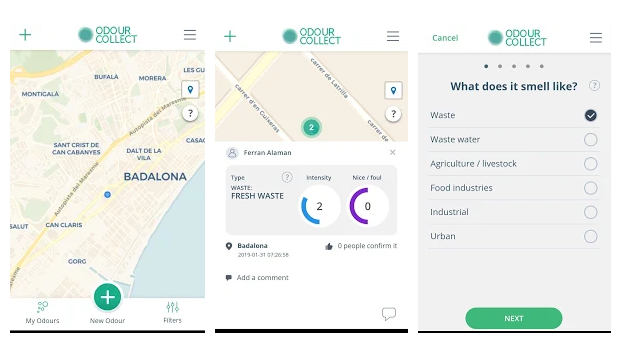The D-NOSES Methodology relies on citizen science. While it can be easily understood that this means that citizens will be involved in creating scientific data, it can be more difficult to understand how this can produce reliable, unbiased data. It can never be overstated how important it is for scientists to follow well established protocols that ensure that the experimental data they collect is as accurate and reliable as possible. If the data is unreliable, then so are the conclusions, and so the data cannot be used. How can citizens, with no formal scientific training, be expected to deliver useable data?
D-NOSES has tackled the data reliability issue in several ways:
The first significant factor to increase the accuracy of data is to simplify the collection. The complex, traditional, odour recognition and impact measuring methodologies have been reduced to 2 observations a citizen must make. These are related to the intensity of the perceived odour and the hedonic tone. While the intensity represents the strength of the odour, the hedonic tone essentially is a measure of how pleasant or unpleasant the odour is. This simplification of the measurements reduces the chances of mistakes or misperceptions in recording observations.
Another significant factor to increase the reliability of data coming from untrained citizens is, quite simply, to train them. One of the activities in the citizen engagement process is a simplified odour recognition workshop that is used to educate people in the basic principles and practice of recognising and reporting odours. While not all people reporting odour observations will have necessarily been trained, by increasing the number that have, the overall reliability is also increased.

Even with training, there is always the risk of personal bias affecting individual data points. This possible bias can usually be detected through a statistical approach. If more people report an odour, at a particular location and at a certain time, it can be determined that this is a reliable observation. The real-time and continuous nature of the data collection in this case offers a clear advantage over the more traditional survey response methods.
While some statistics may remove individual bias, what about collective bias? After all, the people reporting odour issues are also the ones affected by it. This is where D-NOSES will be testing different methods in the pilot studies. One of the methods that D-NOSES will be testing is the use of an advanced model that incorporates geographical and weather data for the regions being monitored making it possible to determine the probable path that an odour has taken before being observed by a citizen volunteer. This could be used to try to identify a credible source of the odours.

While this is not a validation technique, this model could contribute to the datasets in two important ways. In the first place, it could be used to check if there are other observations that match the calculated path taken, which might add credibility to the individual odour reports. The path calculation also could allow the identification of the possible source of the odours by examining the path taken and checking if there are odour emitters along the way. If the source can be established, the model can also be used to link the perceived odours to the time the odour was released. With access to information about the emitters activities at that time, the D-NOSES team of experts might be able to diagnose possible problems and suggest relevant solutions. This is just one of the techniques that The D-NOSES team will be validating and evaluating throughout the project and the pilot case studies.
As stated earlier. the validation of the data is a vital component of the D-NOSES method and citizen science in general. Only if we can show that the data is reliable can we expect the relevant stakeholders to take appropriate action.The techniques outlined above are enough to show that it is in theory possible to collect reliable scientific data from regular citizens. The various pilots, some of which have already started, will then provide the scientific evidence that this is true. Everyone can contribute to this effort by using the OdourCollect app, either online or on their mobile phones. The more data we can collect, the stronger the case that can be made for remedial action.
